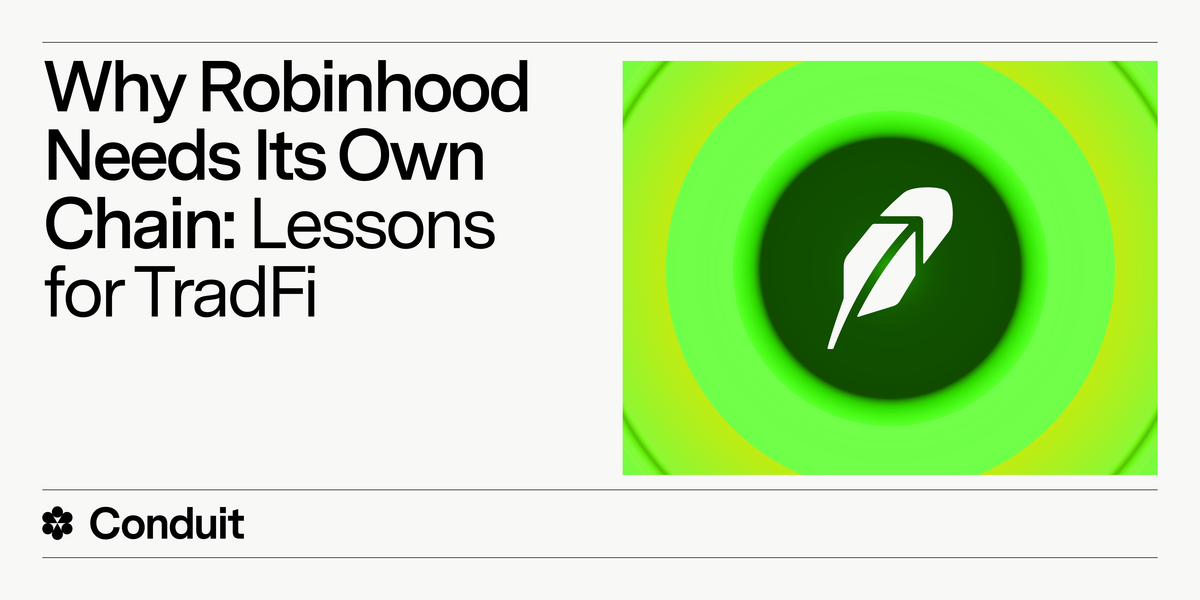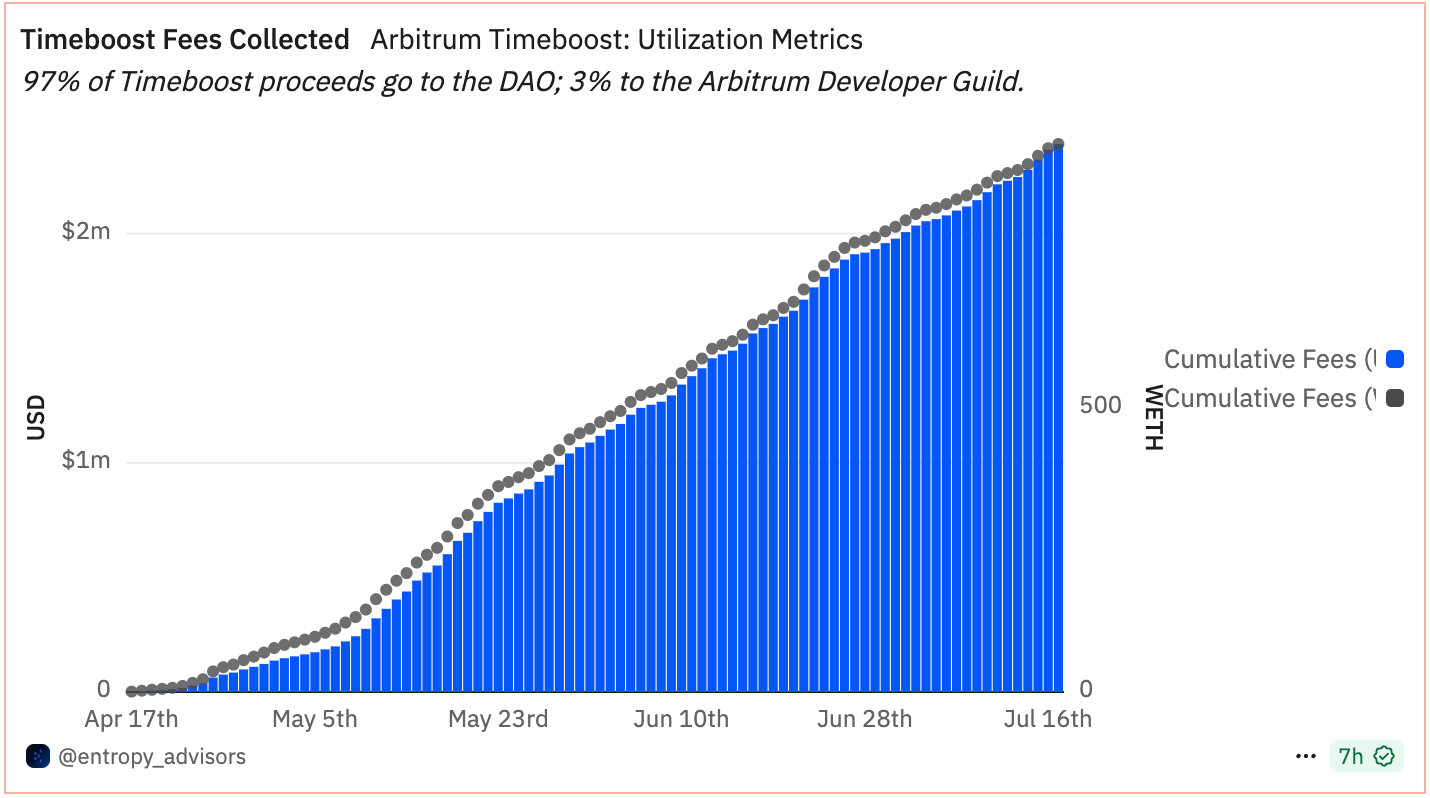Why Robinhood Needs Its Own Chain: Lessons for TradFi
Robinhood's decision to launch a dedicated chain is one we're confident many other fintech and tradfi firms will follow. Here's why.

At EthCC, Robinhood revealed plans to launch its own dedicated blockchain: Robinhood Chain, built on Arbitrum Orbit and optimized for real world assets.
Robinhood's decision to launch a dedicated chain is one we're confident many other fintech and tradfi firms will follow. The writing is on the wall: If you want to compete in the next era of finance, you need to own your infrastructure, not rent it.
We’re going to show you why by walking through all the ways a dedicated chain makes the vision Robinhood outlines possible. To be clear, we have no inside information here. But based on their product, public statements, and our experience building high-performance chains at Conduit, we’ll lay out the reasons Robinhood needs its own chain, and why we think other TradFi and web2 firms will follow suit.
1. Scale and performance
Robinhood operates at massive scale, and its long-term vision is for all financial markets to move onchain. What would that look like for Robinhood? In May 2025, the platform averaged 4 million trades per day. That activity isn’t spread out evenly – research suggests 40% of trading happens in the first two hours after market open. So, even before accounting for black swan events like 2021’s meme stock frenzy, future platform growth, and other onchain apps Robinhood wants to eventually host onchain, we should assume Robinhood must be prepared to handle roughly 220 TPS to support current activity.
That's significantly more TPS than Base – the biggest chain with Ethereum-comparable security – normally processes today. So, it’s easy to see how Robinhood could face serious performance bottlenecks on any shared chain during activity spikes, whether from its own users or other applications competing for block space.
Be a landlord, not a tenant https://t.co/AMLpmnKq1b
— Andrew Huang ⚡️⛓️ (@KAndrewHuang) July 6, 2025
A dedicated chain lets Robinhood be a landlord and not a tenant. When you're processing millions of trades daily, you can't afford network congestion caused by someone else's application.
2. Better economics
When you own the chain, the economics fundamentally change in your favor. Instead of paying gas fees to someone else, you get to collect them yourself as revenue, and only pay for data availability. Every dollar users pay in gas fees on Robinhood Chain goes to Robinhood – no one else. For a platform processing 4 million trades daily, even small per-transaction fees add up substantially.
Chain owners have other methods to increase revenue as well, like MEV internalization. As an Arbitrum Orbit chain, Robinhood Chain will be able to take advantage of Timeboost, which has generated $2.4 million on Arbitrum One since April.

Other chains can use Flashbots Rollup-Boost for similar MEV opportunities.
Gas fees and MEV internalization are just two of several ways chain operators can increase revenue compared to apps on shared chains.
3. Better UX
At the announcement keynote, Vlad Tenev repeatedly emphasized that Robinhood needs to make blockchain's technical complexity invisible to users. The UX needs to be as smooth as their centralized app is today.
A dedicated chain allows Robinhood to optimize the entire user experience from day one by baking in account abstraction tooling – gas sponsorship, smart accounts, social logins, etc. Could they implement those tools as an app on a shared blockchain? Yes. But think about the number of Robinhood users whose first onchain experience will be on this app. On a shared chain, those users would still need to set up wallets, save their seed phrases, and navigate the difficulties of self-custody before hitting Robinhood’s app. A dedicated chain eliminates that friction and enables Robinhood to own the entire onchain experience.
And of course, the increased performance we discussed in point one also adds to user experience by ensuring traders can always complete transactions quickly, even during periods of high activity.
4. Customizability
A dedicated chain also offers customization options unavailable on a shared network, beyond the user experience optimizations we discussed above.
For instance: A custom gas token. There’s no word yet on whether Robinhood plans to implement one, but the option is there on a dedicated chain. Shared chains lock apps in to the L1’s native gas token, but if Robinhood wants, they can use their USDG stablecoin, a new token they launch themselves, or an existing alternative.
Arbitrum Stylus is another customization Robinhood can opt into as an Orbit chain. Stylus allows chains to support smart contracts coded in more traditional programming languages like Rust and C++. That expands the pool of developers who can build on the chain and unlocks significant performance improvements.
Deeper customizations can also enable Robinhood Chain’s RWA use case better than a shared chain. For instance, native pre-compiles can support asset custody proofs, dividend payments, and stock splits more efficiently and cheaply than is possible on a shared chain that isn’t optimized for RWAs.
5. Compliance baked in
Perhaps the most compelling reason for financial services companies to launch dedicated chains is that they can build compliance guardrails directly into their infrastructure. Platforms like Robinhood face extensive requirements: KYC/KYB, AML monitoring, OFAC sanctions screening, geographic restrictions, and market protection mechanisms.
A dedicated chain provides multiple enforcement layers to meet those requirements:
- Bridge level restrictions can limit access to the chain itself based on credential and identify verification before allowing deposits.
- Sequencer-level restrictions enable real-time transaction screening, automatically rejecting blacklisted addresses or implementing trading halts on specific assets during periods of volatility.
- RPC-level restrictions allow for IP-based screening and geofencing, while maintaining seamless access to permitted users and regions.
When you own the chain, meeting compliance requirements becomes significantly easier and more auditable.
This is the start of a bigger trend
Robinhood's chain launch isn’t happening in a vacuum. JPMorgan is coming around to stablecoins. Blackrock has an entire fund onchain. Traditional exchanges like NYSE and Nasdaq are investigating tokenization.
We believe that all major financial players will come to recognize that their blockspace is too important to share with other apps.
As Tenev noted, tokenization represents finance's biggest innovation in the past decade. But to fully realize tokenization's benefits, financial institutions need infrastructure they can control, customize, and optimize for their specific needs. And Conduit is available to help them nail this era-defining transition to onchain.

